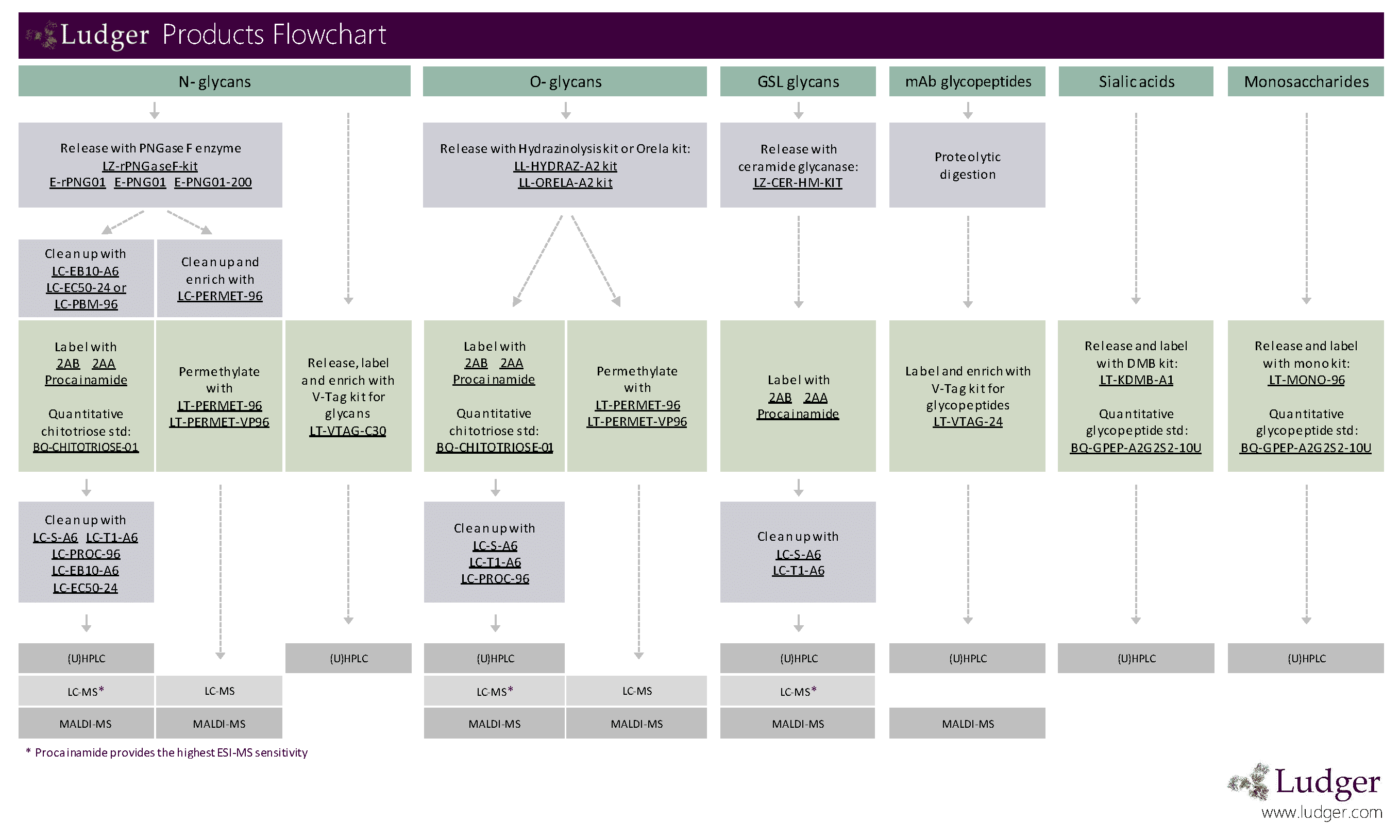Quantitative Monosaccharide Release and Labelling Kits 定量單醣與標記
示意圖
產品描述

Quantitative Sialic Acid Release and DMB Labelling Kit
- 內容包含三個唾液酸標準品
- 適用於HPLC 和UHPLC 分析

Quantitative Monosaccharide Release and 2-AA Labelling Kit
- 可滿足 ICH Q6B 指南進行單醣分析
- 內含MonoMix 單醣標準品(葡萄糖胺、半乳糖胺、半乳糖、甘露糖和岩藻糖)與內標準品(木醣)
Glycan Labelling and Derivatisation Kits 聚醣標記與衍生化
示意圖
產品描述

2-AB glycan labelling kits
- 醣基化分析中使用最廣泛的螢光標記之一
- 提供的還原劑分為:Sodium cyanoborohydride 或 2-PB(24/96)

Procainamide glycan labelling kits
- 可通過質譜儀或 (U)HPLC 進行聚醣分析
- 適用於 N-聚醣、O-聚醣、GSL-聚醣、肝素或任何具有還原末端的醣
- 提供的還原劑分為:Sodium cyanoborohydride (24/96) 或 2-PB

2-AA glycan labelling kits
- 醣基化分析中使用最廣泛的螢光標記之一
- 提供的還原劑分為:Sodium cyanoborohydride 或 2-PB

V-TAG glycan release and labelling kit
- 將醣蛋白的N-聚醣進行釋放、標記
- 敏感度更高,且操作簡單、快速
- 符合 ICH Q2 驗證

V-TAG glycan release and labelling kit
- 將醣蛋白的N-聚醣進行釋放、標記
- 敏感度更高,且操作簡單、快速
- 符合 ICH Q2 驗證
Glycopeptides Labelling Kits 醣肽標記試劑
示意圖
產品描述

V-TAG glycopeptide labelling and enrichment kit
- 用於標記、富集 mAb 醣肽的試劑盒
- 敏感度更高,且操作簡單、快速
- 符合 ICH Q2 驗證
應用分享
疾病研究
2020 Nature Communication
- 腸道微生物會利用黏蛋白作為營養來源,作者分析微生物的代謝機制可更好地解影響人類消化系統相關疾病的潛在治療措施。
- 結果顯示內切 O- 聚醣酶於腸道內的作用機制,並於潰瘍性結腸炎組織和結直腸癌細胞產生的黏蛋白發現顯著的寡醣差異,表示具有發展為診斷腸道疾病的檢測工具。

癌症研究
2018 Journal of Allergy and Clinical Immunology
Engineering and stable production of recombinant IgE for cancer immunotherapy and AllergoOncology.
- AllergoOncology 是癌症免疫學的新興學科,旨在利用過敏相關免疫的特徵來治療腫瘤。作者開發一種可以穩定表達重組IgE 的方法,以應用於癌症治療。
- 不同培養基會影響細胞分泌抗體的品質,包括轉譯後修飾。作者檢測不同濃度的培養基表達的重組 IgE 需進行聚醣分析,以了解其結構及功能性。

參考資料
- Crouch, L.I., Liberato, M.V., Urbanowicz, P.A. et al. Prominent members of the human gut microbiota express endo-acting O-glycanases to initiate mucin breakdown. Nat Commun 11, 4017 (2020). https://doi.org/10.1038/s41467-020-17847-5
- Crescioli, S., Chiaruttini, G., Mele, S., Ilieva, K. M., Pellizzari, G., Spencer, D., Gardner, R. A., Lacy, K. E., Spicer, J. F., Tutt, A., Wagner, G. K., & Karagiannis, S. N. (2018). Engineering and stable production of recombinant IgE for cancer immunotherapy and AllergoOncology. The Journal of allergy and clinical immunology, 141(4), 1519–1523.e9. https://doi.org/10.1016/j.jaci.2017.12.986




